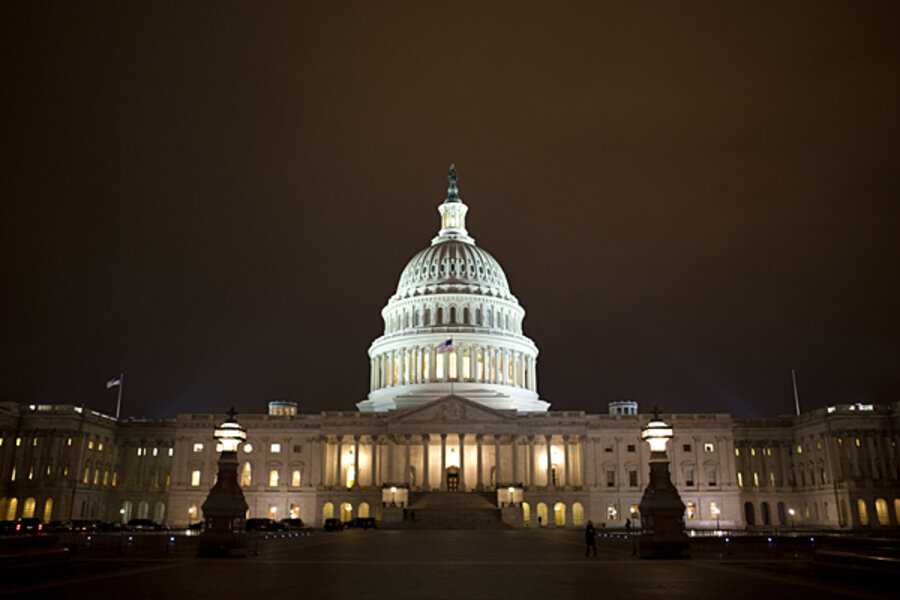After the fiscal cliff comes the debt ceiling
Loading...
“It’s not all I would have liked,” says Republican Senator Lindsey Graham of South Carolina, speaking of the deal on the fiscal cliff, “so on to the debt ceiling.”
The battle over the fiscal cliff was only a prelude to the coming battle over raising the debt ceiling – a battle that will likely continue through early March, when the Treasury runs out of tricks to avoid a default on the nation’s debt.
The White House’s and Democrats’ single biggest failure in the cliff negotiations was not getting Republicans’ agreement to raise the debt ceiling.
The last time the debt ceiling had to be raised, in 2011, Republicans demanded major cuts in programs for the poor as well as Medicare and Social Security.
They got some concessions from the White House but didn’t get what they wanted – which led us to the fiscal cliff.
So we’ve come full circle.
On it goes, battle after battle in what seems an unending war that began with the election of Tea-Party Republicans in November, 2010.
Don’t be fooled. This war was never over the federal budget deficit.
In fact, federal deficits are dropping as a percent of the total economy.
For the fiscal year ending in September 2009, the deficit was 10.1 percent of the gross domestic product, the value of all goods and services produced in America. In 2010, it was 9 percent. In 2011, 8.7 percent. In the 2012 fiscal year, it was down to 7 percent.
The deficit ballooned in 2009 because of the Great Recession. It knocked so many people out of work that tax revenues dropped to the lowest share of the economy in over sixty years. (The Bush tax cuts on the rich also reduced revenues.) The recession also boosted government spending on a stimulus program and on safety nets like unemployment insurance and food stamps.
But as the nation slowly emerges from recession, more people are employed — generating more tax revenues, and requiring less spending on safety nets and stimulus. That’s why the deficit is shrinking.
Yes, deficits are projected to rise again in coming years as a percent of GDP. But that’s mainly due to the rising costs of health care, along with aging baby boomers who are expected to need more medical treatment.
Health care already consumes 18 percent of the total economy and almost a quarter of the federal budget (mostly in Medicare and Medicaid).
So if the ongoing war between Republicans and Democrats was really over those future budget deficits, you might expect Republicans and Democrats to be focusing on ways to hold down future healthcare costs.
They might be debating how to make the cost controls in the Affordable Care Act more effective, for example, or the merits of moving to a more efficient single-payer system, as every other advanced country has done.
But they’re not debating this, because the federal deficit is not what this war is about.
It’s about the size of government. Tea-Party Republicans (and other congressional Republicans worried about a Tea-Party challenge in their next primary) want the government to be much smaller.
“My goal,” says conservative guru Grover Norquist, “is to cut government in half in twenty-five years, to get it down to the size where we can drown it in the bathtub.”
What’s behind this zeal to shrink government? It’s not that the U.S. government has suddenly become larger. In fact, non-military government spending relative to the size of the U.S. economy remains the smallest of any other rich nation.
Apart from the military, Medicare and Social Security account for almost everything else the federal government does – and these programs continue to be hugely popular, as Republicans learn every time they threaten them.
The animus toward government has more to do with the growing frustrations of many Americans that they’re not getting ahead no matter how hard they work.
Government is an easy scapegoat, utilized by much of corporate America to convince average Americans to cut taxes, spending, and regulations — and divert attention from record-high corporate profits and concentration of income and wealth at the top.
The median wage continues to drop, adjusted for inflation, even though the economy is growing. And the share of the economy going to wages rather than to profits is the smallest on record.
Increasingly it’s looked like the game is rigged, especially when people see government bailing out Wall Street (the Tea Party movement grew out of the bailout, as did the Occupiers), and handing out corporate welfare to big agriculture, big pharma, oil companies, and the insurance industry, to name but a few of the recipients.
The outrage grows when average working people are told – falsely — that a growing portion of Americans don’t pay taxes and live off government handouts.
The battle over the fiscal cliff is over, but the trench warfare will continue.






